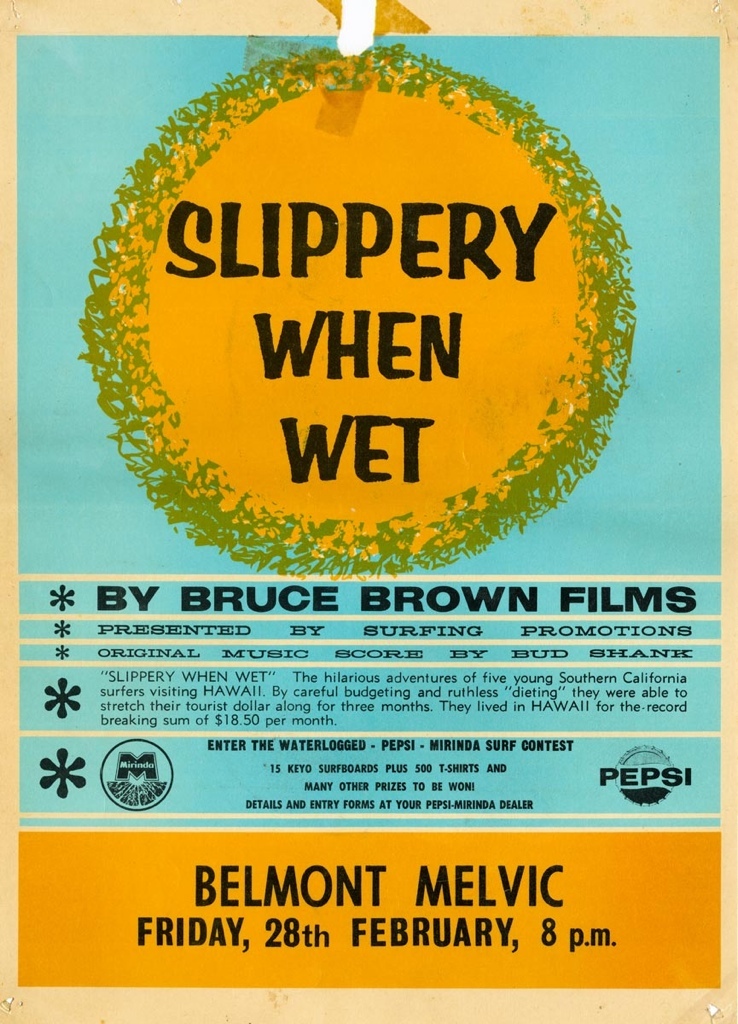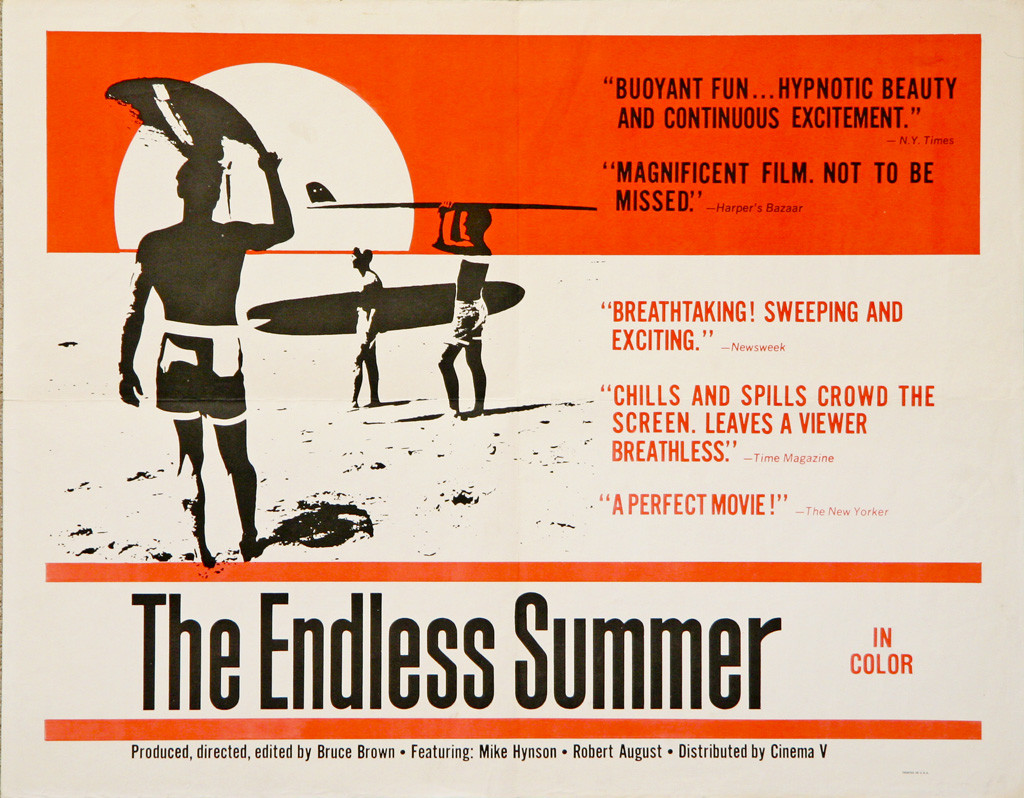Summer means many different things to different people. To some it might mean the thrill of a high speed catamaran. Others like to float around and soak up a few stray rays. Still others like some kind of inland activity. But for us, it's the sport of surfing.
The first trick was to find a camera that was waterproof, and there weren't too many of those in the 1950's. He had taken many, many photos and much 8mm film of the surf and the surfers with other cameras, beginning with some photos he made for his mother when he was a high school kid so that she could see that the surfing he did [mostly instead of going to high school] wasn't dangerous and wouldn't result in a broken neck. Although, to be fair, the waves where he surfed in Alamitos Bay could be wild, even in the days before the construction of the Long Beach breakwall, but what sons don't keep a little bit from their mothers?
Anyway, Brown enjoyed the water and the surf, no surprise since he hung out at the Huntington Beach pier, the place that bears the closest resemblance to my view of the Kingdom of Heaven, and equally enjoyed trying to capture the kinetic action of surfing on film. So much so that he joined the Navy out of high school and made sure he graduated at the top of his class in submarine school so that he would have his choice of assignments. He chose Hawaii, the home of Waikiki, the North Shore, Waimea, and the Banzai Pipeline.
After the Navy he became a life guard in San Clemente, trying to save money for that rad camera that would make all the difference, when he heard that the master surfboard shaper, Dale Velzy, was offering $5000 for a film that would highlight the Velzy surf team and the company's product. This was 1957, when $5000 had the buying power that over $40,000 has today. This would mean not only a waterproof camera but travel and living expenses for a whole year. So, in a mad gamble, Brown quit his day job, took the money, bought the camera, and lived out of his beater Ford for the next year. All he did was surf, sleep in the car, travel back and forth from California and Hawaii, and, oh, yes, take miles of 8mm film of surf, surfers, surfing life, and surfing styles. The result was the documentary Slippery When Wet, narrated by Brown with a soundtrack by the mildly demented alto saxophonist, Bud Shank.

There were other surf films at the time, but none had the laid-back panache of Brown's. As was the custom in the late 1950's, these films would be shown in high school auditoriums, at midnight shows in local movie theaters, or even on the outside walls of buildings on Friday or Saturday nights in SoCa. Sometimes, they would not even have sound and the filmmakers would narrate them live. Not only did Brown's film offer a soundtrack, he gradually, over the course of making Slippery's sequels, Surf Crazy, Barefoot Adventure, Surfing Hollow Days and Waterlogged, learn how to distribute a surfing documentary so that it could be released like any Hollywood film.
 |
| What surfers once looked like when they traveled. Heck, what everyone once looked like when they traveled. August, Hynson, and Brown boarding a plane. |

Here's an academic description of the film:
"In his narration, Brown muses that if someone had enough time and money, they could literally follow the summer around the globe, and so Brown and two of his surfing buddies, Robert August and Mike Hynson, decide to do just that. With their surfboards as luggage, August and Henson travel from one coastline to the next, trying the waves in Hawaii, Africa, Australia, Tahiti, and a number of other nations where most folks had never even seen a surfboard before. Along the way, August and Hynson learn a lot about people around the world, and grow up a bit while they search for the elusive perfect wave."
Here's what Roger Ebert had to say:
"The peculiar charm of "The Endless Summer" is something I haven't got quite worked out in my mind yet. This is all the more strange because here, at last, is a completely uncomplicated film, fresh and natural, designed only to please. It does."
If people thought that surfing was about Frankie, Annette and playing bingo on a beach blanket, or what was captured in the insipid songs of the Beach Boys, Endless Summer rectified that misconception. It is by turns lyrical and absurd, comical and rather sweetly touching; it is very much a product of those particular days in the middle of the 1960's, before drugs, Charlie Manson [another fellow who enjoyed hanging out in Huntington Beach, by the way], and the rancid horror of Vietnam began to discolor history. The two surfers of the film, August and Hynson, reflect in their personal histories the twin experiences of surfing in the period now known as post-Summer.
Robert August took the smart route, turning his minor celebrity into a surfboard conglomerate that also offers skateboards, clothing, and anything else that feeds the surfing lifestyle. He still surfs in HB or at his estate in Costa Rica and looks about twenty years younger than his age. Hynson chose the stupid path and surrendered to drug addiction and smuggling, joined a notorious criminal gang and took the better part of four tragic decades to re-build his life. To see those two young men in the film is to see a portion of our own history, with its successes and its excesses, revealed in an uncommon pursuit for the perfect wave.
Brown would continue to create documentaries, not all of them about surfing. In the early 1970's, he would join with actor Steve McQueen to make a motorcycle racing documentary titled On Any Sunday, which would be nominated for an Academy Award. There would also be a sequel in Endless Summer II, but the times had changed by 1994 and the charm in that film is a little forced.
Brown still lives by the ocean, managing his catalog of fims and giving interviews. In a recent story, he spoke of his next goal: "Robert August sent me a new board -- for a fat man. He called and said, 'What are you doing, letting the resin cure?' I've been quite the hodad lately, but I'll be back at it soon."
All of his films, including those early black-and-white ones, are available in downloadable form via Netflix or Hulu or Amazon Prime or what have you.
Here's the original trailer for Endless Summer. I won't watch it until the end because I will suddenly have the urge to go out to the garage and wax my [Robert August] surfboard.
